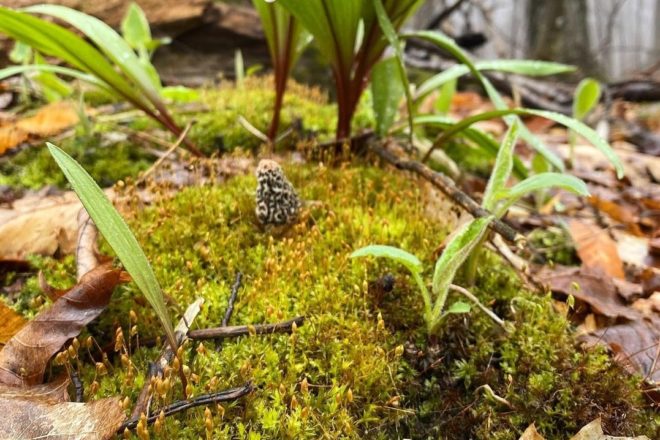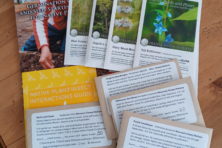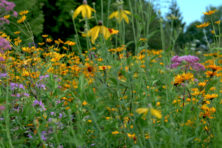Spring Foraging: Wild edible plants to gather now
- Share
- Tweet
- Pin
- Share

As temperatures begin to rise and hearty winter dishes take a back seat to fresh greens and salads, this time of year offers an ideal opportunity to try your hand at foraging for tasty spring edibles.
“[Foraging] is the beautiful intersection of going on a hike that’s productive and coming home from that hike with dinner,” said Jamie Mead, an avid forager who, in turn, incorporates her love of foraging into her work.
Even before Mead and her partner, Matt Chambas, started Door County Underground, a pop-up restaurant that focuses on locally farmed and foraged ingredients, she said she was drawn to foraging because of the intentionality it added to her hikes and her time spent in nature.
“You can’t help but get excited about it,” she said.
In Door County, ramps – or wild leeks – are one of the first edible plants to burst through the forest floor. They’re a type of wild onion with a distinctive, garlicky-onion flavor that some find overwhelming, but others, such as Mead, find them to be a welcome treat.
“I think the flavor is enhanced since we’ve been deprived of fresh local greens [all winter],” she said. “It’s that lacking that we experience that enhances the flavor of the ramps.”
Ramps are identified by two to three broad, smooth, richly green leaves that are flat and broader than their bulbs. The aroma – pungent and sweet – is a dead giveaway when you walk into a patch.
Both the leaves and the bulb are edible, but it isn’t necessary to pull the bulb from the ground when harvesting ramps.
“In fact, you should always leave the roots behind unless you’re making a recipe specific to the bulb or picking the bulbs,” Mead said. “You can just clip and take the leaves, which are just as delicious. It makes it easier to harvest, too.”

If foraging for ramps, keep an eye out for trout lily, which often grows nearby. Both medicinal and edible, the leaves of the trout lily have a slightly sweet flavor, and the corms, also edible, have been described as having a mild, cucumber-like taste.
“The leaves are similar to a ramp as far as being a wide lobe, but these have reddish-purple dots around them,” Mead explained.
The leaves, which are edible raw, are easier to harvest from the plant as well.
“When you pull the leaf, it’s very tender,” she said.
The flavor is bright and citrusy, but don’t let their tastiness lead you to eat mass quantities in a day. That’s because they’re also classified as an emetic – a substance that causes vomiting. Sprinkled over a salad, made into a tea or roasted to accompany your entrée, however, they can be a delectable spring treat.
Though it raises a few eyebrows when mentioned, another of Mead’s favorite springtime finds is stinging nettle. This highly nutritious green grows throughout the summer, but the early shoots are the most tender. They’re also easier to harvest earlier in the season.

Stinging nettle is a tall, perennial plant with serrated, heart-shaped leaves. They’re fairly easy to identify, especially if you brush up against them with a bare arm or hand. The stinging “hairs” that cover the plant are most dense on the stem, but once cooked down, those hairs soften and lose their sting.
“Eating them raw is not the way to go,” Mead said. “But steaming them or cooking them in a soup is absolutely delicious.”
Her preferred way to prepare stinging nettles is in chimichurri sauce.
“You can tell you’re eating something really healthy and good for you,” she said. “High in vitamin C and potassium, they’re just a really cool and underused superfood. It’s so exciting to eat it.”
But not everything you find is worth harvesting.
“It’s really good to learn when something is too early or too far gone and what that looks like,” Mead said. “You don’t pick and eat everything you find. Instead, you want to know, what does it look like when it is really fresh?”
If you’re new to foraging, the best way to learn is by going with someone who’s more experienced. Mead said she learned most of what she knows from Chambas, who has incorporated foraging into his cooking for as long as she’s known him. She also relied on guidebooks early on.
“But I kept it in my car,” she said. “My rule was, if I wasn’t sure what it was, I didn’t touch it.”
Instead, she would take a picture of the plant with her phone and then consult the guidebooks after her hike.
“Save yourself the trouble of carrying something you don’t want,” Mead said. “You can always research it and come back to it.”
Her phone is also a handy tool in documenting her foraging adventures.
“Our phones are so helpful now because you can get the date stamp and the location of where you were,” she said. “You’re able to look back and see what you got where and when.”
When foraging for any edible plants, Mead encourages people to do so sustainably. When harvesting trout lily, for example, take just one leaf, and harvest from different areas. When harvesting ramps, leave the bulbs in the ground if they’re not needed in the recipe, and take them from only a plant or two in each patch.
“Foraging is a wonderful way to get to know your environment better,” Mead said, “but it’s so important that people learn how to do it sustainably. Learn how to forage smartly so the environment comes back and continues to sustain you.”



